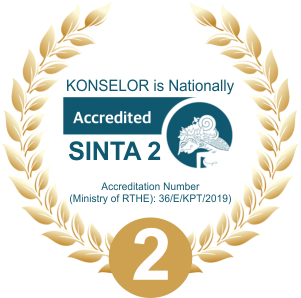The factors influence the implementation of character education in Kuttab Al Fatih
 ), Rosnidar Mansor(2),
), Rosnidar Mansor(2), (1) Malikussaleh University
(2) Sultan Idris Education University, Tanjung Malim- Malaysia
 Corresponding Author
Corresponding Author
Copyright (c) 2021 Hafnidar Hafnidar, Rosnidar Mansor
DOI : https://doi.org/10.24036/02021104114451-0-00
Full Text:
 Language : en
Language : en
Abstract
Keywords
References
Al-Ghazali, M. (2004). Muslim’s character. New Delhi, India: Islamic Book Service.
Al-Ghazali. (2016). Ihya Ulumuddin. Syaikh Jamaluddin Al-Qasimi (trans). Jakarta: PT Darul Falah.
Azumadi Azra. (2015). Genealogy of Indonesian Islamic Education: Roles in the Modernization of Muslim Society. Heritage of Nusantara. International Journal of Religious Literature and Heritage, 4 (1), 85-114.
Allen, K., & Bull, A. (2018). Following Policy : A Network Ethnography of the UK Character Education Policy Community. 1–21. https://doi.org/10.1177/1360780418769678
Baharun, H. (2017). Total Moral Quality: A New Approach for Character Education in Pesantren. Ulumuna, 21(1), 57–80. https://doi.org/10.20414/ujis.v21i1.1167
Duckworth, A., & Yeager, D. (2015). Masalah pengukuran. Peneliti Pendidikan, 44 (4), 237-251. Retriever, from doi:10.3102/0013189X15584327.
Dishon, G., & Goodman, J. F. (2017). No-excuses for character: A critique of character education in no-excuses charter schools. Theory and Research in Education, 15 (2). Retrieved, from https://doi.org/10.1177/1477878517720162.
Erola, J., Jalonen, S., & Lehti, H. (2016). Parental education, class and income over early life course and children’s achievement. Research in Social Stratification and Mobility, 44, 33–43. Retrieved, from https://doi.org/10.1016/j.rssm.2016.01.003.
Gelisli, Y., & Beisenbayeva, L. (2015). Comparison of 12-Year Comsulsory Education in Turkey and Kazakhsan. Procedia - Social and Behavioral Sciences, 197(February), 1827–1834. https://doi.org/10.1016/j.sbspro.2015.07.242
Ibnu Khaldun. (2016). Muqaddimah. Transleted by Akhmadi Thoha, Cet. II. Jakarta: Pustaka Firdaus.
Mei-Ju, C., Chen-Hsin, Y., & Pin-Chen, H. (2014). The beauty of character education on preschool children’s parent-child relationship. Procedia-Social and Behavioral Sciences, 143, 527–533. Retrieved, from https://doi.org/10.1016/j.sbspro.2014.07.431.
Park, D., Tsukayama, E., Goodwin, G. P., Patrick, S., & Duckworth, A. L. (2017). A tripartite taxonomy of character: Evidence for intrapersonal, interpersonal, and intellectual competencies in children. Contemporary Educational Psychology, 48, 16-27. Retrieved, from https://doi.org/10.1016/j.cedpsych.2016.08.001.
Ruch, W., Weber, M., Park, N., & Peterson.C. (2014).Character strengths in children and adolescents reliability and initial validity of the german.European Journal of Psychological Assessment, 3. Retrieved from: https://doi.org/10.1027/1015-5759/a000169
Reeves, R., & Halikias, D. (2017). Race Gaps In SAT Scores Highlight Inequality and Hinder Upward Mobility. Washington, DC: Brookings Institute.
Ülger, M., Yiğittir, S., & Ercan, O. (2014). Secondary School Teachers’ Beliefs on Character Education Competency. Procedia - Social and Behavioral Sciences, 131(4310), 442–449. Retrieved from: https://doi.org/10.1016/j.sbspro.2014.04.145
Ulil Amri Syafri. (2016). Pendidikan Karakter Berbasis Al-Quran. Jakarta: PT Raja Grafindo Persada.
Wynne, E. (1997). For character education. In A. Molnar (Ed.). The construction of children’s character The construction of children’s character: Ninety-sixth yearbook of the national society for the study of education (pp. 63–76). Chicago, IL: University of Chicago Press.
 Article Metrics
Article Metrics
 Abstract Views : 479 times
Abstract Views : 479 times
 PDF Downloaded : 80 times
PDF Downloaded : 80 times
Refbacks
- There are currently no refbacks.
Copyright (c) 2021 Hafnidar Hafnidar, Rosnidar Mansor

This work is licensed under a Creative Commons Attribution 4.0 International License.







